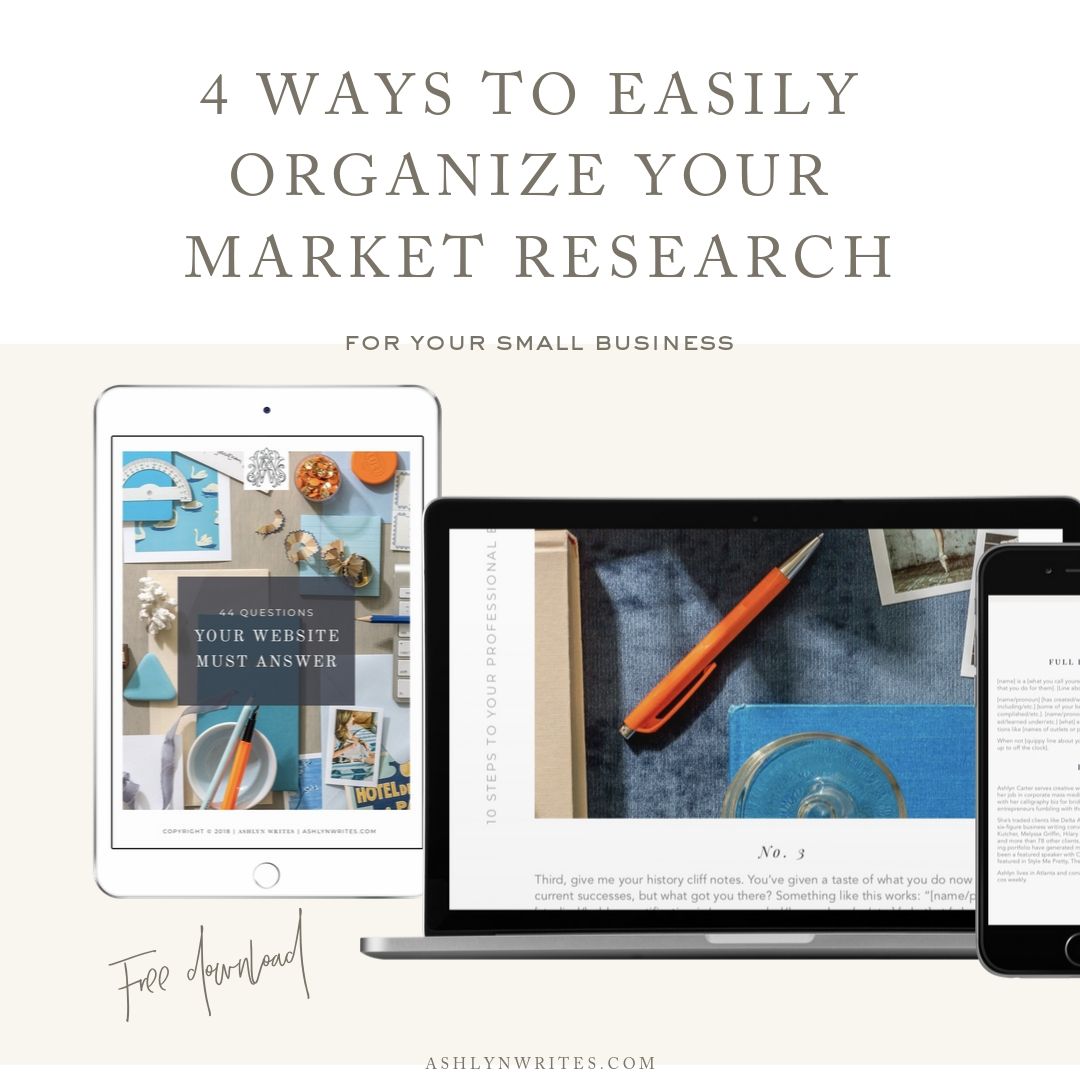Your market research and voice of customer data is your secret weapon when it comes to writing copy that converts—but, it can also be an absolute bear to organize in a way that comes in handy when it’s time to start writing … especially if you have a large amount of it.

So … how do you organize it in a way where it’s neatly sorted and at your fingertips when you write your website, sales page, or email newsletter or funnel?
From the headline ripped straight out of a previous photography client’s inquiry form submission, the ad copy story pulled from an email a web design customer sent in telling you exactly the phrase they heard over and over in their head before finding you, to the description of your floral design services copied borderline verbatim from the comments section of a Betches bridal article (TRUE LIFE: I’ve done all of these.) …
… hacking your client or customer’s voice and getting it down “on paper” is key to copy that converts.
I’m sharing what you need to keep in mind and some exact ways I organize my research as a copywriter so you can start speaking straight to your ideal target’s pain points and increase your sales.
So lemme ask you this: do you like to give your opinion on things you care about? Yeah? Most of us do!
I mean, we like to share. (There’s a whole thing called social media created around that.) A survey by Meltwater showed 73 percent share information because it helps them connect with others who share their interests, and 94% of people share information to better the lives of others. We like to give our opinions.
Once you understand that copywriting is about organizing your ideal customer’s language and feedback—and not actually about writing anything new, per se—you can create copy that gets your audience to read, remember, and buy from you.
There are TONS of ways to do market research. I mean, off the top of my head, I can think of customer or client interviews, surveys, focus groups, and just looking with your own two eyes at the landscape … and that’s without thinking too hard.
You can also learn a TON by trial and error of your new product or latest service! Diligent research can help you really figure out pricing, what you’re putting into your product, and more. But the shining star? It can help you write killer copy to market your product or service.
Now, I’m not talking so much about how to DO the research as much as what you do with it when you get it all back and start to use it to craft copy.
And a quick note—if you aren’t doing research before you do marketing for your business, you won’t see nearly the sales growth that you would if you keep your ear to the ground and listen to your people. My students inside CfC know I’m obsessed with teaching step-by-step how to launch a survey or conduct client or customer voice hacking interviews. I’m obsessed ‘cause it’s important!
TIP 1:
Okay, so the first thing: how to organize your research digitally. This’ll make it easier to come back to and reference when you’re writing that sales page, homepage, or email newsletter. Now, if you’re a beginner in getting your copy up to snuff for your small business, this is so very important. Why?
Well, because your job as the messaging CEO of your creative business—which you are as the boss—is to know enough to be dangerous about pulling together language from a variety of sources, organizing it in a way that increases conversions.
Now, if that makes copywriting sound easy—know that it’s still a challenge, and there’s more to know (that’s why I’m here for you) but you as the DIY copywriter for your business, you need to be at least a good enough marketer to know what audience language is compelling enough to swipe for your, as you’ll hear me call it, copy bank.
Let’s dive in.
So as a DIY copywriter, setting up a digital copy bank is key to getting organized, because it’s giving you a spot to pull from as you craft different pieces of messaging for your business, helping your Facebook ads convert, helping you figure out pieces of content to lead into pre-launch for your new digital course, and more.
In order to start getting organized, you’ll want to pick your poison with a great free tool—whether it’s a spreadsheet, an online tool like Evernote, Asana, or Trello, or—if you’re a copywriter managing multiple clients and multiple projects—you’ll probably want to bake the cost of a tool like Airstory into your cost of services.
I work in Airstory, and since I tend to work in projects, I categorize my research by client and project now.
But for my own business? It looks different. It started simply as a Google spreadsheet.
You need to go in and first and foremost, get a system set up to add your copy swipes to. I’ve done everything from separated documents with pasted-in quotes that relate to certain subjects used as section headers, to building spreadsheets to sort survey results. More than anything, you’ve got to set up a system you can make sense of and USE.
To my students inside Copywriting for Creatives™, I always suggest keeping their Brand Messaging Style Guide—the document that has in-depth research and info about their own brand positioning and voice—nearby, as well.
Related: How to Write Copy that Actually Converts
Tip 2
The next thing we’re going to look at is digitizing any client calls, whether it’s a kick-off call or consultation, a session itself, or a client or customer feedback interview you conducted.
A really important thing to remember—I say this all the time—the best copy isn’t in your head, it’s in your client’s head.
Let me give you an example.
For a recent client campaign, I needed a short story to kick off a Facebook ad driving to a webinar. My client had mentioned a little anecdote to me on a call. Quickly realizing the golden nuggets she was likely giving me, while we were talking, I said hang on, let me record this, and I sent it off to get transcribed so I could just chat with her during our client call.
She was affiliating with a respected mentor of hers, and she told me some great stories from that first use moment with the product she was helping launch … plus, a story about when she first told her mom she wanted to teach an online course.
… well, it ended up being the ad copy lead for an ad that converted and beat out the other ad we tested—and that was more of a controversial lead, so it was even a tiny bit longer. (Which would’ve made us expect it to do better!)
Stories sell. 😉 It got to the point across a bit faster, too.
All we’re going to do to transcribe a client call is pop into Rev.com (Seriously, it’s the best—we’ve tried other things!), drop in the video recording, and get it transcribed. Then, when I get it back, it’s nice and neat in a new file, and I can copy/paste copy to pull into my Copy Bank that I told you about.
Tip 3:
Next thing we’re going to look at in our market research organization is tagging what you’ve got so you can find it quickly and easily.
We want to dogear the copy swipes in your bank based on how you’d use it—so this is a project-specific task. I like to either duplicate the data and make a fresh Google Docs spreadsheet or Airstory project so I can tag it accordingly. This is when it’s helpful for me to either print out the copy swipes and work through (#oldschool) with a highlighter, or just work directly digitally.
So if we go through a spreadsheet, we’d duplicate it and keep our eyes peeled for info that’s a pain point, a desire, something that my program or service solves. I tag things—#pain-point, #big-idea, #desire, #objection. (Those are some of the main buckets I like to use.)
Now, this begs me to say something that might sound obvious, but when you’re doing surveys, make sure you’re getting qualitative info—that’s a fancy way of saying you’re getting them to freestyle instead of asking yes or no questions.
Now, one little trick to keep in mind: look for trends—but swipe the sticky.
(As a bonus tip: I learned this recently and thought I’d share—try to say “what do YOU call that” when you’re interviewing your clients, real or prospective, about what they need/want from you.)
Now, before you start writing, whether it’s your sales page or welcome sequence, a simple newsletter, the homepage of your website or your client inquiry magazine, start with your research. I hope you’re seeing the value in that!
If you really want to dive into this and get serious about using client or customer voice hacking to write better sales copy for your creative small business, make sure that you grab my free checklist of 44 questions that your website must answer—it’ll give you so many ideas of how you can ramp up conversions in your business on your website using data from your copy bank.
Grab that checklist of 44 questions you need in your business, and let me know below—what is the one thing that you’re excited about getting feedback from your audience from in your business? Whether it’s your inquiry response template revamp or a Facebook ad you’ve been dreading writing, it’s so nice to know it’s not 100% dependent on the words that come out of your head, right?
“When I write an advertisement, I don’t want you to tell me that you find it ‘creative.’ I want you to find it so interesting that you buy the product.” -Ogilvy
Reading Time: 6 Minutes Reading time: 7 min. Your market research and voice of customer data is your secret weapon when it comes to writing copy that converts—but, it can also be an absolute bear to organize in a way that comes in handy when it’s time to start writing … especially if you have a large amount of […]




comments +